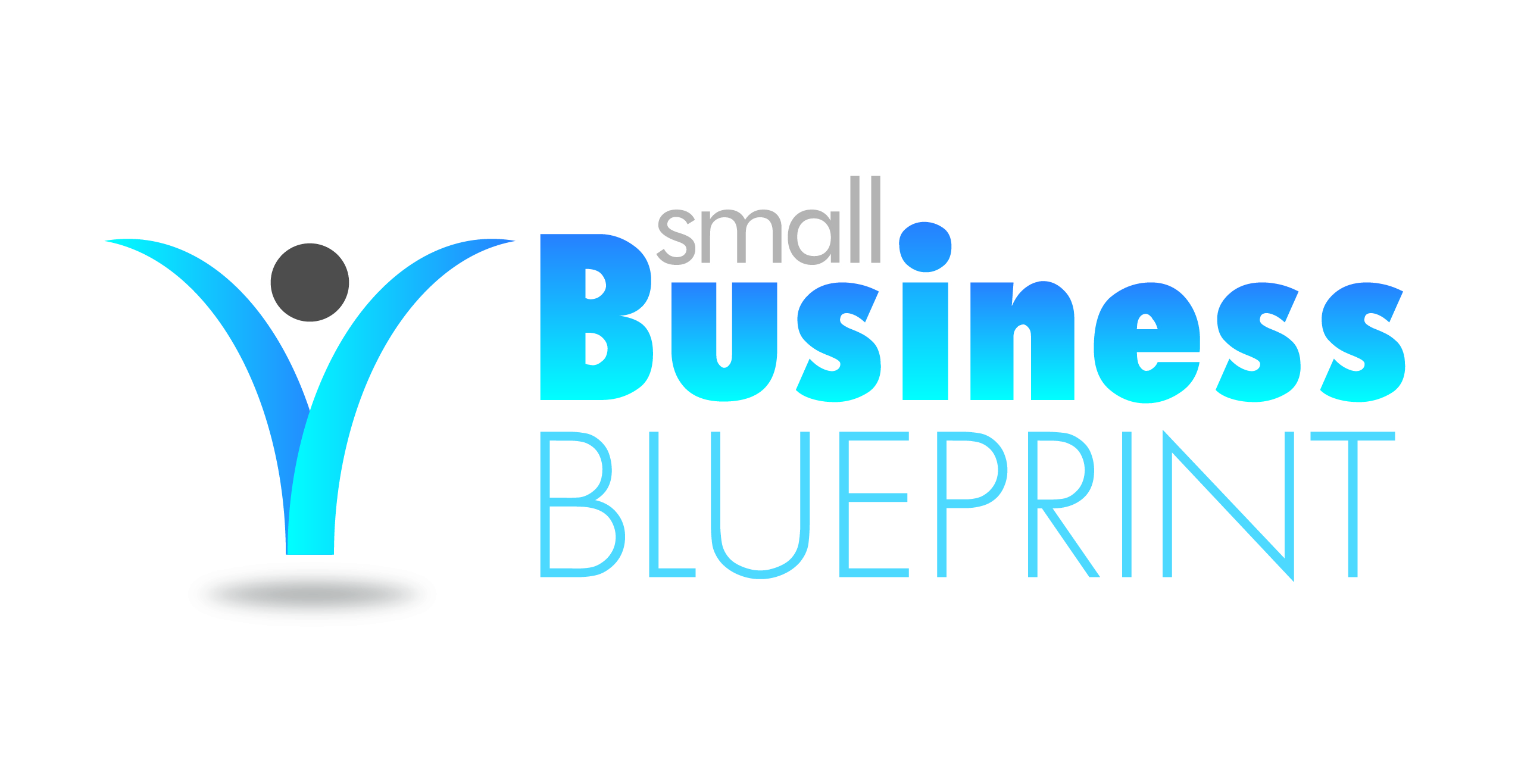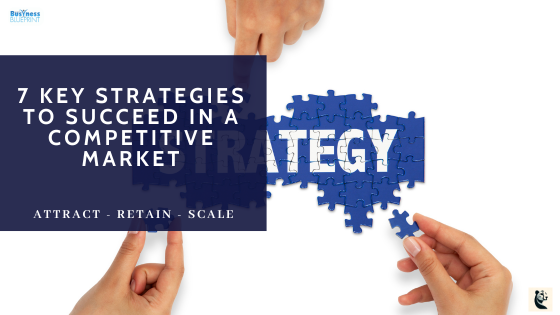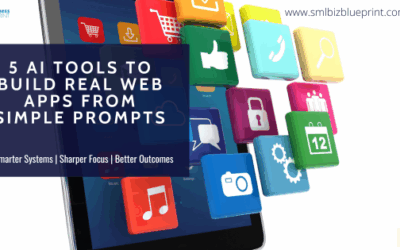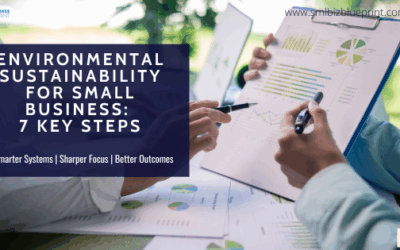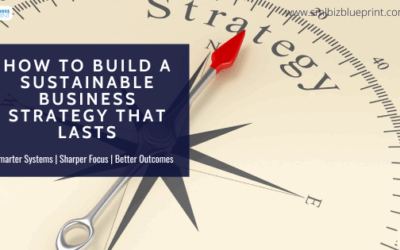With AI, automation, and digital transformation reshaping industries, staying ahead in 2025 is no longer about just keeping up—it’s about adapting smarter and faster than the competition.
For many businesses, the challenge isn’t just about growth but survival.
Rising costs, shifting consumer expectations, and market saturation make it harder for small and mid-sized businesses to compete effectively.
A staggering 45% of businesses that failed in the last five years cited “lack of market differentiation” as a core reason (McKinsey, 2024).
So, how do you build a sustainable competitive advantage in 2025?
How do you ensure your business survives and thrives in this ever-changing market?
This guide provides a battle-tested roadmap outlining seven key strategies modern businesses must implement to succeed.
From leveraging AI for marketing and sales to optimising financial management and customer retention, we’ll walk you through practical, actionable steps to help you dominate your industry.
What You’ll Learn in This Guide
- ✅ The top business trends shaping 2025 and how to capitalise on them.
- ✅ How to build a competitive advantage and stand out in a crowded market.
- ✅ The most effective marketing strategies for customer acquisition & retention.
- ✅ How to leverage AI & automation to boost efficiency and scale your business.
- ✅ Smart financial strategies to ensure profitability and resilience.
The companies that adapt and innovate in 2025 will be the ones that dominate their industries.
Let’s dive in. 🚀

#1 The Business Landscape in 2025: Trends You Need to Know
The way businesses operate is changing at an unprecedented pace.
Advancements in AI, automation, and digitalisation are creating new opportunities—but also intensifying competition.
Consumer expectations are higher than ever, and businesses that fail to evolve risk becoming obsolete.
What does this mean for small and mid-sized businesses?
To stay ahead, you need to understand the key trends shaping 2025 and adjust your strategy accordingly.
Here are the top three shifts that will define business success this year.
AI & Automation Are Reshaping Business Operations
Automation is no longer just for large enterprises—small businesses are adopting AI-powered tools at an accelerating rate.
From AI-driven customer support to automated data analysis, businesses that integrate AI are seeing higher efficiency, reduced costs, and improved decision-making.
💡 How AI is Driving Business Success in 2025:
Automated Sales & Lead Generation: AI-driven sales processes can cut lead response times by up to 70%, increasing deal closures.
Operational Efficiency: AI-powered analytics reduce time spent on manual tasks by 40%, allowing teams to focus on strategic growth.
🔹 What You Should Do:
Start integrating AI-powered chatbots, automated CRM tools, and predictive analytics into your workflow to improve efficiency and customer engagement.
The Customer Experience is the New Battleground
Modern consumers expect more than good products—they want seamless, personalised, and frictionless experiences across all touchpoints.
Brands that fail to prioritise customer experience (CX) will struggle to maintain customer loyalty in 2025.
🚀 Key CX Trends for 2025:
Hyper-Personalization: AI-driven insights allow businesses to deliver tailored recommendations and customised experiences.
Omnichannel Engagement: Businesses need to offer a unified experience across websites, social media, mobile apps, and in-person interactions.
Frictionless Transactions: Consumers expect one-click purchases, instant support, and self-service options to save time.
🔹 What You Should Do:
Use AI-driven analytics to segment your customers and deliver personalised offers.
Implement seamless omnichannel communication (chatbots, email automation, SMS).
Optimise your website for speed and mobile friendliness. 73% of web traffic now comes from mobile devices (Statista, 2024).
Sustainability & Social Responsibility Are Business Imperatives
Consumers are demanding more accountability from brands. A sustainable, ethical business model is no longer optional—it’s a competitive advantage.
Brands that fail to adopt eco-friendly practices risk losing customers and missing out on valuable partnerships.
🌱 How Sustainability Impacts Business Growth:
Consumer Demand: 70% of customers prefer brands prioritising sustainability (IBM, 2024).
Regulatory Pressure: Governments are tightening regulations on carbon emissions and waste reduction.
Cost Savings: Sustainable practices (e.g., energy-efficient production, supply chain optimisation) reduce operational costs.
🔹 What You Should Do:
Transition to eco-friendly packaging & supply chains.
Highlight sustainability initiatives in marketing & branding.
Partner with socially responsible organisations to build credibility.
Tips
✔️ Leverage AI and automation to streamline operations and improve efficiency.
✔️ Enhance customer experience with hyper-personalization and seamless digital interactions.
✔️ Adopt sustainable practices to meet consumer expectations and regulatory standards.
By understanding and acting on these trends, your business will be well-positioned for success in 2025.
#2 Building a Competitive Advantage in 2025
In 2025, businesses that fail to differentiate themselves will struggle to survive.
The marketplace is more crowded than ever, and with AI-driven automation, global competition, and evolving consumer expectations, standing out is no longer a luxury—it’s a necessity.
But what exactly gives a business a competitive edge?
It’s not just about offering a great product or service; it’s about creating a compelling reason for customers to choose you over competitors.
Below are three critical strategies to build a sustainable competitive advantage this year.
Define & Amplify Your Unique Selling Proposition (USP)
Your USP is your business’s fingerprint—the one thing that makes your brand irreplaceable.
Yet, many businesses struggle to articulate what sets them apart clearly.
🚀 Key USP Differentiators in 2025:
AI-Powered Personalization: Customers now expect businesses to anticipate their needs and provide customised recommendations.
Convenience & Speed: Fast, seamless interactions (one-click checkouts, AI-driven customer service) are winning customers over.
Niche Expertise: Instead of trying to be everything to everyone, dominating a specific market segment builds stronger loyalty.
💡 Example:
Tesla vs. Other EV Brands – Tesla’s USP isn’t just about electric cars; it’s about autonomous driving, a unique charging network, and tech innovation.
🔹 What You Should Do:
Identify the one thing your business does better than anyone else.
Ensure your marketing, messaging, and product offerings consistently reinforce your USP.
Regularly analyse customer feedback to refine and improve your unique value.
Leverage AI for Market Research & Consumer Insights
Successful businesses make data-driven decisions. In 2025, leveraging AI-powered analytics helps businesses understand customer needs, predict market trends, and optimise pricing strategies.
📊 How AI Gives You a Competitive Edge:
Predictive Analytics: AI can analyse historical customer data to forecast buying behaviour.
Competitor Monitoring: AI-powered tools like SEMrush and Brandwatch track industry trends and competitor moves.
Automated A/B Testing: AI optimises marketing campaigns by testing different ad creatives, copy, and offers in real time.
🔹 What You Should Do:
AI-powered CRM software (HubSpot, Salesforce) can be used to track customer behavior and fine-tune marketing.
Implement automated chatbots & AI-driven support to improve engagement and reduce response times.
Run AI-powered market analysis to identify gaps and opportunities in your industry.
Build a Brand That Consumers Trust & Remember
A strong brand identity is a significant competitive advantage in 2025. Consumers are bombarded with choices, and a business with a recognisable, trustworthy brand is likelier to succeed.
Elements of a Powerful Brand in 2025:
Authenticity & Transparency: Consumers trust brands that are genuine and socially responsible.
Consistent Messaging Across Platforms: Your website, social media, and ads should reinforce one clear brand identity.
Storytelling That Resonates: People connect with stories—brand storytelling creates emotional bonds with customers.
🔹 What You Should Do:
Audit your brand messaging – is it consistent across platforms?
Showcase real customer success stories and testimonials to build credibility.
Engage with your audience on social media with value-driven content, not just sales pitches.
Tips
- Find and amplify your USP—be known for one thing that sets you apart.
- Use AI & market research to stay ahead of consumer trends and competition.
- Build brand trust and credibility with transparency, consistency, and storytelling.
By implementing these strategies, you’ll position your business ahead of the competition in 2025.
Ready to level up your business?
Sign up for our newsletter and get expert tips delivered weekly.
#3 Marketing Strategies for 2025: What Works and What Doesn’t
Marketing is evolving faster than ever, and what worked in 2023 or 2024 may no longer be effective in 2025.
Businesses must adopt strategies that cut through the noise, engage audiences, and drive conversions.
Traditional marketing tactics are becoming less effective, while AI, automation, and personalisation are shaping the future of marketing success.
If you want to attract and retain customers, here’s what’s working right now—and what’s not.
Hyper-Personalization: The Era of Tailored Marketing
Generic, one-size-fits-all marketing no longer works. In 2025, customers expect brands to know their needs before they do.
Personalisation must go beyond using a first name in an email—it must be predictive, data-driven, and AI-powered.
How Personalization Boosts Marketing Performance:
AI-driven email campaigns increase open rates by 26% and conversions by 32% (Campaign Monitor, 2024).
Personalised product recommendations drive up to 35% of total revenue for eCommerce brands (McKinsey, 2024).
Websites using AI-based personalisation see a 10-15% lift in sales (Forbes, 2024).
🔹 What You Should Do:
Use AI-powered email segmentation to send targeted content based on customer behaviour.
Leverage dynamic website content (like Amazon’s recommendation engine) to personalise offers.
Utilise predictive analytics to anticipate customer needs and adjust messaging accordingly.
The Rise of Short-Form & Video Content
In 2025, video continues to dominate, but attention spans are getting shorter.
Businesses that rely solely on blog posts or long-form ads are missing out on massive engagement potential.
Why Short-Form Video is Essential:
85% of social media users prefer short-form videos over static posts (HubSpot, 2024).
TikTok, YouTube Shorts, and Instagram Reels drive higher brand engagement and shares than any other format.
Videos under 60 seconds have a 52% higher completion rate than longer videos.
🔹 What You Should Do:
Repurpose blog content into bite-sized videos for social media.
Use AI-generated captions and translations to reach a broader audience.
Keep brand videos short, engaging, and actionable—avoid fluff.
AI & Automation: Smarter Marketing, Less Work
AI is no longer a luxury—it’s necessary to scale marketing efforts efficiently. From content generation to automated chatbots, AI frees time and boosts engagement.
How AI Enhances Marketing Performance:
AI-generated content can produce high-quality blog posts, ad copy, and social media captions in seconds.
Chatbots & AI assistants can handle up to 80% of customer inquiries, reducing the need for human support (Salesforce, 2024).
Automated A/B testing optimises campaigns 5x faster than manual processes.
🔹 What You Should Do:
Use AI-powered tools like ChatGPT for content creation and Jasper for AI-assisted copywriting.
Automate lead nurturing with AI-powered email sequences.
Implement chatbots to provide instant responses to customer queries.
❌ What No Longer Works in 2025?
🚫 Generic mass emails – Customers now expect tailored content, not blanket promotions.
🚫 Relying solely on organic reach – Social media algorithms favor paid promotions and video content.
🚫 Ignoring AI & automation – Businesses that fail to integrate AI tools are being left behind.
Tips
- ✔️ Use AI-powered personalisation to tailor every customer interaction.
- ✔️ Prioritize short-form videos to maximise engagement and brand awareness.
- ✔️ Automate your marketing efforts to scale efficiently without burning out.
By applying these high-impact marketing strategies, your business will cut through the noise and dominate your industry in 2025.
#4 Increasing Sales in a Competitive Industry
With markets becoming more saturated and customers having more choices than ever, increasing sales in 2025 requires more than just traditional selling tactics.
Businesses that focus on customer experience, optimised pricing, and AI-driven sales strategies will be the ones that thrive.
If you want to boost revenue and outpace competitors, here’s how to make every customer interaction count and turn leads into loyal buyers.
Optimise Your Sales Funnel for Maximum Conversions
A poorly optimised sales funnel means losing potential customers before they even purchase.
Today’s buyers expect a frictionless, seamless purchasing process, and businesses that fail to meet these expectations will see high drop-off rates.
How Funnel Optimisation Increases Sales:
Businesses optimising their sales funnels have up to 50% higher conversion rates (Forrester, 2024).
Reducing the number of checkout steps can increase completed purchases by 35% (Baymard Institute, 2024).
🔹 What You Should Do:
Simplify your checkout process – Fewer steps mean fewer abandoned carts.
Leverage AI-driven lead nurturing – Automated follow-ups can recapture lost leads.
Use retargeting ads – Bring back potential customers who didn’t complete their purchase.
Implement Smart Pricing Strategies
Pricing isn’t just about being the cheapest—it’s about understanding your customers’ perceived value.
If your pricing strategy doesn’t align with your customer’s expectations, you risk losing sales to competitors who price smarter.
High-Impact Pricing Strategies for 2025:
Dynamic Pricing: Adjust prices based on demand, competitor pricing, and customer behaviour.
Bundling & Upselling: Offer complementary products together at a discounted package price.
Psychological Pricing: Ending prices in .99 or .97 can subtly increase conversions.
Why Pricing Strategy Matters:
79% of customers say price is a key deciding factor when choosing between brands (PwC, 2024).
Bundled products increase average order value by 30% (Harvard Business Review, 2024).
🔹 What You Should Do:
A/B test different pricing models to see what converts best.
Offer time-sensitive discounts to create urgency.
Use AI-powered pricing tools to optimise for maximum profitability automatically.
Focus on Customer Retention & Loyalty Programs
While attracting new customers is important, retaining existing ones is far more profitable.
Loyal customers spend more over time and are more likely to refer others—making customer retention one of the most effective ways to increase sales.
Customer Retention Benefits:
A 5% increase in retention can boost profits by 25-95% (Harvard Business Review, 2024).
Loyal customers are 5x more likely to make repeat purchases than new ones (Forbes, 2024).
How to Boost Customer Retention in 2025:
Implement a loyalty program – Offer exclusive perks, discounts, or rewards for repeat customers.
Improve post-purchase engagement – Follow up with personalised recommendations and support.
Use AI-powered CRM tools – Predict when customers will likely churn and proactively re-engage them.
🔹 What You Should Do:
Offer VIP tiers to incentivise long-term customer relationships.
Use email automation to keep customers engaged after their first purchase.
Track customer lifetime value (LTV) and tailor your retention strategy accordingly.
Tips
- ✔️ Optimize your sales funnel to remove friction and reduce abandoned carts.
- ✔️ Use smart pricing strategies like bundling, upselling, and AI-powered dynamic pricing.
- ✔️ Invest in customer retention through loyalty programs, personalised offers, and AI-driven engagement.
By applying these strategies, you’ll increase sales and create a loyal customer base that keeps coming back.

#5 Leveraging AI and Automation for Business Growth
The businesses thriving in 2025 aren’t just working harder—they’re working smarter.
With AI and automation, companies can streamline operations, personalise customer experiences, and scale more efficiently.
AI-driven decision-making and automation tools are no longer just for large corporations—small and mid-sized businesses that integrate intelligent automation into their marketing, sales, and operations will outperform competitors in efficiency, customer satisfaction, and profitability.
Here’s how to leverage AI and automation to grow your business faster and smarter.
AI-Powered Customer Engagement & Support
Consumers today expect instant, seamless interactions with brands. If your business relies solely on human customer service, you’re missing huge opportunities to improve efficiency and engagement.
AI-driven tools like chatbots and virtual assistants can handle inquiries, resolve issues, and guide customers through the buying process—24/7.
How AI-Powered Engagement Boosts Business Performance:
Chatbots and AI assistants can handle 80% of routine customer inquiries, freeing up human support teams (Salesforce, 2024).
AI-powered customer interactions improve retention rates by 30% due to faster response times (HubSpot, 2024).
🔹 What You Should Do:
Implement AI chatbots on your website and social media for instant customer support.
Use AI-driven email automation to personalise responses and nurture leads.
Leverage voice assistants and AI-powered call routing to reduce response time for high-value inquiries.
Automating Marketing & Sales for Scalability
AI-driven marketing automation is eliminating manual work and helping businesses scale at unprecedented speeds.
Businesses can generate leads, convert customers, and maximise revenue by automating repetitive tasks without increasing headcount.
🚀 High-Impact Marketing & Sales Automation Strategies:
AI-Powered Email Marketing: Automated email sequences boost lead nurturing and conversions by over 40% (Campaign Monitor, 2024).
Predictive Lead Scoring: AI identifies and prioritises the most valuable leads, increasing sales team efficiency.
Automated A/B Testing: AI quickly tests and optimises ads, landing pages, and offers for higher conversion rates.
🔹 What You Should Do:
Use AI-driven CRM tools (HubSpot, Salesforce) to track and nurture leads automatically.
Automate social media scheduling with AI tools like Buffer or Hootsuite.
Leverage predictive analytics to identify the best times and channels for marketing outreach.
AI-Driven Business Insights & Decision-Making
AI isn’t just about automation—it’s about making smarter, data-driven decisions that improve performance.
Businesses using AI-driven analytics can predict market trends, identify inefficiencies, and optimise operations better than competitors relying on guesswork.
How AI Enhances Business Strategy:
AI-driven analytics improve decision-making accuracy by 37% (Deloitte, 2024).
Companies using AI-based forecasting reduce inventory waste by 35% and improve profitability (McKinsey, 2024).
🔹 What You Should Do:
Implement AI-powered business intelligence (BI) tools to track key performance metrics.
Use predictive analytics to forecast demand and adjust pricing strategies accordingly.
Leverage AI-driven competitor analysis to stay ahead of industry trends.
Tips
- ✔️ Automate customer support with AI chatbots to improve engagement and free up human resources.
- ✔️ Use AI-driven marketing automation to personalise campaigns and optimise sales funnels.
- ✔️ Leverage predictive analytics for smarter business decisions and demand forecasting.
Integrating AI and automation into your business will enhance efficiency, reduce costs, and unlock new growth opportunities.
#6 Financial Strategies for Stability and Growth
In 2025, financial stability isn’t just about cutting costs—it’s about thoughtful financial planning, strategic investments, and optimising cash flow to ensure long-term business growth.
With rising operational costs, shifting market demands, and unpredictable economic trends, businesses must take a proactive approach to financial management.
Here’s how to strengthen your financial foundation and maintain profitability in a competitive economy.
Master Cash Flow Management
Cash flow is the lifeblood of any business, and poor management is one of the leading causes of business failure.
Without proper cash flow planning, businesses can struggle to cover operational expenses, reinvest in growth, or handle unexpected downturns.
How Strong Cash Flow Management Impacts Business Growth:
82% of small businesses fail due to poor cash flow management (U.S. Bank, 2024).
Companies that monitor cash flow weekly are 33% more likely to be profitable than those that don’t (QuickBooks, 2024).
🔹 What You Should Do:
Automate invoicing & payment reminders to improve collection speed.
Negotiate better supplier terms to extend payment cycles and free up cash.
Maintain a rolling 12-month cash flow forecast to anticipate financial needs.
Diversify Revenue Streams for Stability
Relying on a single revenue stream is a significant financial risk—especially in a volatile economy. Smart businesses diversify their income sources to create financial resilience.
Revenue Diversification Strategies for 2025:
Subscription & Membership Models – Recurring revenue ensures predictable cash flow.
Expanding Digital Offerings – Online courses, e-books, and exclusive content create new income streams.
Partnering for Strategic Collaborations – Joint ventures and affiliate programs increase revenue potential.
Why Revenue Diversification Matters:
Businesses with multiple revenue streams are 31% more likely to survive economic downturns (Harvard Business Review, 2024).
Subscription-based businesses grow 5x faster than traditional businesses (Zuora, 2024).
🔹 What You Should Do:
Explore new markets or product categories aligned with your existing audience.
Offer subscription-based services or premium membership perks.
Monetize expertise through webinars, courses, or consulting services.
Invest in Smart Cost Management (Without Cutting Growth Opportunities)
Reducing costs doesn’t mean cutting corners—it’s about spending smarter. Businesses that optimise operations, eliminate inefficiencies, and leverage technology will maximise profitability without sacrificing growth.
📊 How Smart Cost Management Increases Profitability:
Automating repetitive tasks reduces operational costs by up to 30% (Deloitte, 2024).
Optimising supply chain efficiency can cut expenses by 15-25% (McKinsey, 2024).
🔹 What You Should Do:
Use AI-powered financial forecasting to optimise spending and budgeting.
Negotiate vendor contracts to secure better pricing and payment terms.
Eliminate underperforming marketing spend while doubling down on high-ROI channels.
Tips
- ✔️ Monitor cash flow weekly and automate invoicing for better liquidity.
- ✔️ Diversify revenue streams through subscriptions, digital offerings, or partnerships.
- ✔️ Use AI-driven cost optimisation to cut unnecessary expenses and increase profitability.
Applying these financial strategies allows your business to stay profitable, resilient, and scalable—even in uncertain times.
Don’t miss a beat in your business growth journey!
Join Pulse and stay ahead with expert tips and actionable advice every month.”
Subscribe to Pulse Today
#7 Future-Proofing Your Business for Long-Term Success
The businesses that thrive in 2025 and beyond aren’t just reacting to change—they’re anticipating it, adapting, and positioning themselves for long-term success.
In an era of economic shifts, evolving consumer behaviour, and rapid technological advancements, businesses must be proactive, not reactive.
Future-proofing isn’t about predicting every trend—it’s about building a resilient, adaptable business that can withstand disruptions and capitalise on new opportunities.
Here’s how to ensure your business is built for the long haul.
Embrace Continuous Innovation & Digital Transformation
Innovation is no longer optional—companies that fail to evolve will be left behind.
Whether through AI, automation, or new business models, businesses that embrace change will stay ahead of competitors.
How to Stay Innovative:
Encourage a culture of experimentation—test new ideas without fear of failure.
Leverage AI & automation to streamline processes and increase efficiency.
Stay ahead of industry trends by investing in research & development (R&D).
Why Innovation Matters:
60% of businesses prioritising innovation outperform competitors (Boston Consulting Group, 2024).
Companies that continuously adapt their business model see 33% faster revenue growth than those that don’t (McKinsey, 2024).
🔹 What You Should Do:
Set aside a budget for innovation and technology upgrades.
Monitor emerging industry trends and be willing to pivot when necessary.
Invest in AI-driven tools that enhance efficiency and customer experience.
Build a Resilient Business Model
A business that can withstand economic downturns, market shifts, and industry disruptions is a business that will last. Building resilience means diversifying income streams, reducing risks, and strengthening customer relationships.
How Business Resilience Leads to Growth:
Businesses with diversified revenue streams are 31% more likely to survive economic downturns (Harvard Business Review, 2024).
85% of consumers prefer to buy from brands they perceive as stable and reliable (PwC, 2024).
Ways to Build a Resilient Business Model:
Diversify revenue sources (subscriptions, digital products, partnerships).
Strengthen customer loyalty to create repeat revenue streams.
Develop contingency plans for economic downturns, supply chain issues, and technology disruptions.
🔹 What You Should Do:
Identify vulnerabilities in your current business model and create backup strategies.
Build a customer-centric approach to ensure consistent revenue from repeat buyers.
Leverage AI-powered forecasting to prepare for market changes.
Invest in People & Continuous Learning
The best investment a business can make isn’t just in technology—it’s in its people. A business with skilled, adaptable employees can pivot faster, innovate more, and stay competitive no matter what changes arise.
📊 Why Investing in Talent is Critical:
Companies that invest in employee training see 24% higher profit margins (LinkedIn Workplace Report, 2024).
Businesses prioritising workplace culture are 3x more likely to retain top talent (Glassdoor, 2024).
How to Future-Proof Your Workforce:
Provide ongoing training in AI, data analytics, and digital tools.
Encourage leadership development to build an adaptable team.
Create a culture of innovation where employees are rewarded for experimenting with new ideas.
🔹 What You Should Do:
Offer AI and automation training to ensure employees stay ahead of industry changes.
Foster a culture of continuous learning by providing access to online courses, webinars, and mentorship programs.
Encourage employees to experiment, take risks, and think like entrepreneurs.
Tips
- ✔️ Invest in AI and digital transformation to stay ahead of industry trends.
- ✔️ Diversify revenue streams to ensure financial stability during market shifts.
- ✔️ Build a culture of continuous learning to keep your workforce adaptable.
By future-proofing your business today, you’re ensuring growth, stability, and success for the years ahead.
Conclusion
The business landscape in 2025 is more competitive than ever, but with the right strategies, tools, and mindset, your business can thrive rather than just survive.
You position yourself ahead of the competition by leveraging AI, automation, smart financial planning, and a future-proof mindset.
Let’s recap the seven key strategies:
✅ Understand the 2025 Business Landscape – Stay ahead by embracing AI, automation, and sustainability.
✅ Build a Competitive Advantage – Define your USP, leverage AI insights, and strengthen brand trust.
✅ Implement High-Impact Marketing Strategies – Use AI-driven personalisation, video content, and automation.
✅ Optimize Sales & Pricing Strategies – Streamline sales funnels, adopt smart pricing, and focus on customer retention.
✅ Leverage AI & Automation for Growth – Automate customer engagement, marketing, and business intelligence.
✅ Ensure Financial Stability – Manage cash flow, diversify revenue streams, and cut costs strategically.
✅ Future-Proof Your Business – Innovate, build resilience, and invest in people and continuous learning.
The businesses that embrace these strategies today will dominate their industries tomorrow.
Your Next Steps
Evaluate your current business strategy – Which of these 10 strategies are you already using? Where can you improve?
Start small, but start now – Implement AI-powered tools, optimise your sales funnel, or refine your brand messaging.
Commit to continuous growth – Stay ahead of trends, learn from industry leaders, and innovate your business model.
📢 Ready to take your business to the next level?
💡 Subscribe to our newsletter for expert insights on AI, automation, and business growth strategies.
The future belongs to businesses that adapt, evolve, and take bold action.
Will yours be one of them?
FAQs
Q1: What are the biggest business trends in 2025?
A1: The key trends shaping businesses in 2025 include:
AI and automation improving efficiency and customer experience.
Hyper-personalization in marketing for increased engagement and conversions.
Sustainability is becoming a key business differentiator.
The rise of short-form video content dominates digital marketing.
Increased use of predictive analytics for smarter decision-making.
Q2: How can small businesses stay competitive in a saturated market?
A2: Small businesses can build a competitive edge by:
Defining and amplifying their Unique Selling Proposition (USP).
Leveraging AI for customer insights and automation.
Optimising sales funnels and pricing strategies.
Strengthening customer retention efforts through loyalty programs.
Q3: What marketing strategies are most effective in 2025?
A3: To succeed in 2025, businesses should focus on:
AI-driven personalisation to tailor offers and content.
Short-form video marketing on platforms like TikTok, Instagram Reels, and YouTube Shorts.
Marketing automation to streamline lead nurturing and engagement.
Omnichannel strategies to ensure consistent brand messaging across all platforms.
Q4: How can AI and automation improve business operations?
A4: AI and automation help businesses:
Automate customer support with AI chatbots.
Optimise marketing efforts through AI-driven insights.
Improve financial forecasting and cash flow management.
Enhance efficiency by eliminating repetitive tasks.
Q5: What financial strategies help businesses remain profitable?
A5: To maintain profitability, businesses should:
Manage cash flow effectively by automating invoicing and payment reminders.
Diversify revenue streams to reduce dependency on a single income source.
Use AI-powered cost analysis to optimise spending and budgeting.
Q6: How can businesses future-proof themselves for long-term success?
A6: Future-proofing requires:
Continuous innovation and investment in digital transformation.
A resilient business model that adapts to market changes.
Ongoing employee training and development to keep teams competitive.
AI-driven forecasting and decision-making to stay ahead of industry shifts.
Q7: What are the first steps to implementing these strategies?
A7: Start by:
Assessing your current business strategy – Identify gaps and opportunities.
Prioritising AI and automation tools for efficiency and customer engagement.
Refining your marketing and sales funnel to improve conversions.
Monitoring financial performance and optimising cash flow.
Investing in continuous learning and adaptability to stay ahead.
Other Articles
Your First 30 Days with AI: A Step-by-Step Business Guide
AI for E-Commerce: Top Tools to Automate & Scale
The Secrets of Data-Driven Businesses: How to Track Metrics That Matter
